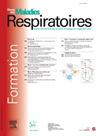Are the behaviors of myogenic progenitors induced by mechanical stretch similar between the human quadriceps and diaphragm?
IF 0.5
4区 医学
Q4 RESPIRATORY SYSTEM
引用次数: 0
Abstract
Introduction
The stretch-induced behaviors of myogenic progenitors from the human diaphragm during mechanical ventilation are poorly understood. In all muscles, following injury, quiescent satellite cells (SCs) become activated, proliferate into myoblasts, and then merge and differentiate to form myotubes. Until now, SC adaptation to injury has been considered similar across various muscles. However, in animal models, transcriptional factors involved in maintaining the quiescent state, such as PAX3 and PAX7, are expressed differently between the diaphragm and quadriceps. In humans, no data currently exist to determine whether differences in stretch-induced behavior of myogenic progenitors during mechanical ventilation exist between these two muscles.
Methods
To address this issue, we purified and characterized human satellite cells from quadriceps and diaphragm biopsies from 11 patients. We then plan to culture these cells on a stretchable PDMS support to develop an in vitro model involving mechanical stress applied to human primary muscle-derived cells. A stretch of 12% of the initial length was applied using a FlexCell apparatus at a frequency of 0.3 Hz to mimic mechanical ventilation in the ICU as showed in Fig. 1.
Results
Our preliminary results (n = 6) show that the Pax7/Pax3 ratio at the myoblast stage, the fusion index, and the surface area at the myotube stage were higher in quadriceps compared to the diaphragm, indicating a higher quality of differentiation (Fig. 2). In a preliminary exploratory experiment, human diaphragm muscle cells from one patient were subjected to different stretching protocols, varying between 2 and 6 days, initiated at different stages of development. Our first results as indicated in Fig. 3 show that the quadriceps and diaphragm cells tolerate the stretching protocol and can proliferate and differentiate under these conditions.
Conclusion
Our preliminary results show that a comparative study between diaphragmatic and quadriceps cells will allow us in the future to assess the sensitivity of these two cell populations to mechanical stress.
机械拉伸诱导的肌源性祖细胞的行为在人的股四头肌和横膈膜之间是否相似?
在机械通气过程中,来自人体膈肌的肌源性祖细胞的拉伸诱导行为尚不清楚。在所有肌肉中,损伤后,静止卫星细胞(SCs)被激活,增殖成肌细胞,然后合并和分化形成肌管。到目前为止,SC对损伤的适应被认为是不同肌肉相似的。然而,在动物模型中,参与维持静止状态的转录因子,如PAX3和PAX7,在横膈膜和股四头肌之间表达不同。在人类中,目前还没有数据来确定这两种肌肉在机械通气时拉伸诱导的肌源性祖细胞行为是否存在差异。方法为了解决这一问题,我们从11例患者的股四头肌和膈肌活检中纯化并鉴定了人卫星细胞。然后,我们计划在可拉伸的PDMS支架上培养这些细胞,以建立一个体外模型,该模型涉及对人类原代肌肉来源细胞施加机械应力。如图1所示,使用FlexCell设备以0.3 Hz的频率施加初始长度12%的拉伸,以模拟ICU中的机械通气。我们的初步结果(n = 6)显示,与横膈膜相比,股四头肌在成肌细胞阶段的Pax7/Pax3比率、融合指数和肌管阶段的表面积更高,表明分化质量更高(图2)。在一项初步的探索性实验中,来自一名患者的人横膈膜细胞在不同的发育阶段进行了不同的拉伸,拉伸时间在2到6天之间。我们的第一个结果如图3所示,表明股四头肌和横膈膜细胞耐受拉伸方案,并能在这些条件下增殖和分化。我们的初步结果表明,横膈肌和股四头肌细胞之间的比较研究将使我们能够在未来评估这两个细胞群体对机械应力的敏感性。
本文章由计算机程序翻译,如有差异,请以英文原文为准。
求助全文
约1分钟内获得全文
求助全文
来源期刊

Revue des maladies respiratoires
医学-呼吸系统
CiteScore
1.10
自引率
16.70%
发文量
168
审稿时长
4-8 weeks
期刊介绍:
La Revue des Maladies Respiratoires est l''organe officiel d''expression scientifique de la Société de Pneumologie de Langue Française (SPLF). Il s''agit d''un média professionnel francophone, à vocation internationale et accessible ici.
La Revue des Maladies Respiratoires est un outil de formation professionnelle post-universitaire pour l''ensemble de la communauté pneumologique francophone. Elle publie sur son site différentes variétés d''articles scientifiques concernant la Pneumologie :
- Editoriaux,
- Articles originaux,
- Revues générales,
- Articles de synthèses,
- Recommandations d''experts et textes de consensus,
- Séries thématiques,
- Cas cliniques,
- Articles « images et diagnostics »,
- Fiches techniques,
- Lettres à la rédaction.
 求助内容:
求助内容: 应助结果提醒方式:
应助结果提醒方式:


